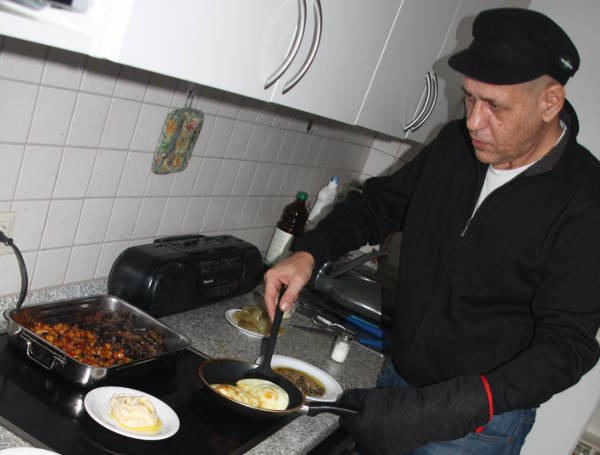(Deutsch:) Willkommen in meinem Kochstudio! Während meiner langen Fastenkur 2014 habe ich damit begonnen, ab und zu Kochfotos mit Kommentaren auf Facebook zu posten. Fastenkur und Kochen? Klingt erst mal paradox, aber beim Fasten koche ich tatsächlich mit der größten Hingabe – für Sabine, die Vegetarierin ist. Einige der Fotos und Rezepte sind ganz gut gelungen, daher entschied ich mich im November dazu, diese kleine neue Sektion einzurichten, auch wenn sie sich unter keine Sparte dieser Site subsumieren lässt.
Was ist besonders an meiner Kochkunst? Genau genommen weiß ich es selbst nicht, aber vielleicht finde ich es unterwegs heraus. Oder Sie finden es heraus, das wäre ja auch schon etwas. Meine Lieblingsküche ist jedenfalls die arabische. Ich liebe auch fernöstliches Essen, vor allem Sushi (überhaupt jede Art von Meeresfrüchten, ich könnte jeden Tag Fisch essen), auch Deutsches wie Spargel. Außerdem lerne ich gern, ob von Franzosen oder Amerikanern oder anderen. Also, viel Vergnügen und Inspiration auf dieser Seite! (Foto: Fantareis)
(English:) Welcome to my Cooking Studio! During my long fasting cure in 2014 I started posting cooking photos on Facebook now and then. Fasting cure and cooking? Sounds paradoxical at first glance, but, as a matter of fact, I indeed cook with the greatest devotion while fasting – for Sabine who is vegetarian. Now, some of the pics and recipes really got well, so I decided in November to launch this new little section of Anis Online, despite the fact that it does not subsume under any of the rubrics on this site.
What is special about my cooking? Actually, I am not sure myself, but maybe I'll find out on the way. Or you find out, that would make sense, too. My favorite cuisine, at any rate, is the Arab one. I also love Far Eastern dishes, most of all sushi (every kind of seafood, as a matter of fact, I could eat fish every day), also German dishes like asparagus. Besides, I like to learn, be it from the French, the Americans or others. So, have fun and inspiration on this page! (Photo: Fantareis) |
 |


